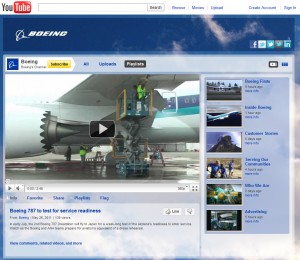
Screen shot of Boeing's new YouTube channel
Social media has become a must-have for most large companies today. Some will approach it with a thought out approach and others do not really know why they are on social media, but just feel they are supposed to be on it. I have enjoyed following Boeing’s slow approach to social media and applaud them for recently adding a YouTube channel.
When I first started this blog about three years ago, the idea of Boeing being on social media was a very foreign concept. Slowly, but surely they have moved from being a company with a closed-door culture to being one that is much more open and shares what is going on with customers and fans of their product.
Boeing first started with operating three Twitter (what is Twitter?) accounts: @Boeing, @BoeingAirplanes and @BoeingDefense. The Twitter accounts cover much more than just repeating news that is already out in the public domain. They have had contests, shared unique photos and personally connected with some of Boeing’s biggest fans.
So why is Boeing on Twitter and YouTube, but not Facebook? Well, the Boeing Store has a Facebook account, but to date Boeing proper still does not. Is this a bad move? Possibly not. Boeing has been taking the “easy-does-it” approach to social media, making sure they master each one before moving onto the next.
When talking to Boeing, it is clear they are looking at how to expand their presence on social media globally, versus just American-based platforms. “We are a global company, ” Todd Blecher, Director of Boeing Communications explained to Airline Reporter. “We need to find ways of becoming a global social media participant.” For example Twitter is not all that popular in China, so Boeing has decided to create a Weibo account to connect with local people and companies.
Adding a YouTube channel is smart, since Boeing is already producing the content. For a long time, Boeing has produced videos to share with employees and it has only been more recently that they have shared these videos via their website. Posting them on YouTube allows more people to view the videos and more importantly, it allows people to comment and interact with Boeing.
YouTube is not the only new thing for Boeing’s videos. On the recent American Airline’s Sky Interior delivery flight, there were only about 20 people on board and Boeing asked a few of the customer-fans who were invited by American Airlines to walk up and down the aircraft at 30,000 feet and give their impression of what they think. No script, no direction, just take a look at the aircraft and give your raw opinion (note: the video has not yet been posted). This is the first time that I have seen Boeing do something like this and it really is a new level of connecting with fans.
Will Boeing continue to grow in other social media formats? I would assume so, but I have been impressed how they continue to better the social media channels they have now to best interact with people outside their company and I look forward to watch them grow.
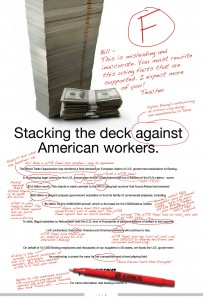
Airbus had a few edits on Boeing's ad. Very creative. Click for larger.
For quite sometime the tension between Boeing and Airbus over the tanker deal and subsidies has created tension. More recently, it seems maybe they are going too far on Twitter, advertisements and comments made.
With Boeing (@Boeing & @BoeingAirplanes) and Airbus (@AirbusInTheUS) recently getting on Twitter, it has become interesting seeing some of the volleys that go back and forth between the companies. Things have been pretty friendly, until news on subsidies surfaced.
I really don’t feel like hashing out all the subsidy stuff, but the bottom line is Boeing accused Airbus of taking illegal subsidies. The World Trade Organization (WTO) found that Airbus took $20billion in illegal subsidies. Boeing has come out pretty saying, “we told you so” (that’s a paraphrase). Then it became Airbus’ turn and now they are stating that the WTO has found Boeing also took illegal subsidies. There is a lot more going on, so if you aren’t up to date, check out Flight Global’s WTO page.
Airbus released the findings on January 31st and during the day they produced nine Tweets talking about the WTO findings and in many, talking directly to Boeing. For example (help with Twitter lingo):
@AirbusInTheUS: “Confused by #Boeing claims that WTO found Airbus got $20B in illegal subsidies? Us too. Here’s the report. http://ow.ly/3NExm No such #’s.”
Okay, I can see one, but nine Tweets? It seemed to be a little much for me. I see Twitter as a way for companies to relate to their customers, not a place to complain directly about a competitor. Sure, if you are Tweeting for yourself, not a company, complain away, but representing a company is something different. You don’t see United Airlines calling out Delta Air Lines on Twitter — it is kept professional as it should.
Boeing also talked about the WTO reports, but were not directly talking to Airbus. Boeing’s approach seems very different to me. Here is an example of Boeing’s tweet on January 31st:
@Boeing: “#Boeing statement on #WTO decision reports http://bit.ly/gRUgXM #Airbus,” and “Video: #Boeing trade expert discusses #WTO www.boeing.com/wto”
I understand that Airbus might have some built up frustration. Not only did Boeing accuse them of getting subsidies and they find Boeing did too, but there is a lot of emotion around the US military tanker deal. The tanker deal has been plagued with delays, decision changes and some pretty messed up situations.
Boeing placed an ad in DC-area newspapers about the subsidies and tweeted it on February 3rd. That Tweet, caused Airbus to respond with two Tweets arguing that the ad was misleading (Tweet1 and 2). But Airbus didn’t stop there. They took Boeing’s ad and made some edits and placed their revised ad in a newsletter targeting the folks on Capital Hill in Washington, DC (see photo with this blog). It seems like Airbus’ edits bring up some interesting points and questions.
In a way, Boeing has an advantage since they have three separate Twitter accounts (their third is on defense). I think this separation was wise. The @BoeingAirplanes has been the more light and “fun” account, connecting with Boeing fans and direct customers. The other two are able to take the brunt of the controversy and have more of a serious tone. Since Airbus only has one feed, it can be difficult to read a serious tweet one second, then the next learning how many ping pong balls can fit into an A380 (by the way, it is 35million). Boeing has also been in the defense business much longer than EADS (the parent company of Airbus). Boeing has been able to learn the ins and outs of defense communications and even has had a lead with social media.
Although Twitter for the two has seemed to calm down, both airline manufactures are still participating in public conflict . EADS North America Chairman Ralph Crosby Jr. recently stated he feels that Boeing cares more about winning the tanker than American troops getting the best product. ’œOur campaign has been based on enabling the understanding of the superior capabilities and value of our system under the rules that are established. And what I see in terms of advertisement and sort of third-party and paid surrogate statements is that, well, whatever (Boeing executives) do, they may or may not win, but they sure want to keep us from winning and, frankly, from my perspective, if that’s anybody’s approach then I think it’s irresponsible to the warfighters.’
Boeing tanker spokesman Bill Barksdale responded by saying, ’œRather than take shots at our European competitor, the Boeing Company continues to focus on being ready to build tankers if we’re honored with a selection and contract award. The selfless men and women of America’s Air Force deserve no less.’
I know there are a lot of complexities and politics involved with this deal, but it seems to me that both companies are spending too much time concerned about insulting the other. That time, effort and money might be used more wisely to work on their own airplane programs.
I think both companies are still in the learning phases of social media. I just hope that whichever company loses the final contract for the tanker can graciously admit defeat and wish the winner the best of luck. I know in the “real” world, that might be too much to ask, but I think in social media, anything is possible.
Image: Seattle PI
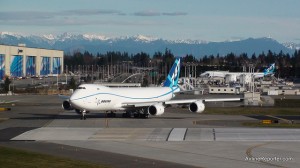
The first Boeing 747-8 completes taxi tests at Paine Field
Not that long ago Boeing entered into the world of social media and I wanted to take a moment to see how it is going.
Personally, I have seen huge changes in the past six months in regards to Boeing and social media. They have come an extremely long way when it comes to connecting with regular people like me and you since I started this blog just over two years ago. By making a huge push, I think they have been highly successful. However, I wanted to see how Boeing feels about their progress.
I decided to speak with Todd Blecher, Communications Director at Boeing based in Chicago, and Bernard Choi, who works for the Communications Department for Boeing Commercial Airplanes in Seattle, to hear their take on Boeing’s progress.
When I asked Blecher if he felt their efforts have been successful he responded with: “I look at success on two levels. The first is whether we consistently generate appealing digital content. The reactions we’ve received since we started using Boeing.com as a storytelling platform and engaging through Twitter lead me to believe that we do.”
Blecher admitted that he wished their numbers were a little higher for the unique content they are creating on their website, but they were very happy with how their efforts at Farnborough turned out. “Our Farnborough micro site was a watershed moment, coming just a few months after we began communicating differently through Boeing.com,” Blecher stated. “We attracted 103,710 visitors who made more than 225,000 visits and 222,300 views of our videos. That was remarkable for us. I’m very proud of that effort.”
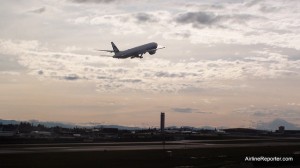
A new Cathay Pacific Boeing 777 test flying at Paine Field
On top of making a lot of great and unique content on their website, Boeing has also been making a great effort to interact with their employees, different airlines and fans on Twitter.
I have found that a lot of companies don’t know how to make Twitter work for them. Many will have a Twitter account because they feel they need one, but they don’t know why. Talking with Blecher, I can tell he gets it. “Social media’s value rests in allowing organizations to engage in a dialogue with people around the world that can benefit both sides of that equation, and do that at very low cost,” he explained. Boeing is not on Twitter because they want to look like they are in-touch, they are on Twitter because they want to change how they communicate to the outside world (being media, airlines and fans like you) permanently and more effectively, using technology.
Working Boeing’s three Twitter accounts (@BoeingAirplanes, @BoeingCorporate and @BoeingDefense) is very much a team effort. Blecher watches over @BoeingCorporate, Choi works on @BoeingAirplanes and Maribeth Bruno in Boeing Defense Communication watches over @BoeingDefense. I know that some larger companies have to go through a lot of hurdles to get something posted to Twitter, but Boeing makes it easy.
I have heard of horror stories from other companies, where they want to Tweet something, but it has to be approved half way around the world by five different people. It might take up to 12 hours to finally Tweet and by then, the moment is lost.

Boeing's hangars in Everett, WA (don't worry I was passenger when taking this photo)
Blecher pointed out that Boeing is actually pretty flexible with allowing people to Tweet. All three of them that oversee the Twitter accounts are trained professionals and are able to use their own judgment on what is alright to Tweet. “Since our tweeters are media relations people by trade we all know what’s ok and what’s not ok for a tweet.” Blecher continued, “We’re used to being on a high wire without a net, so to speak. Therefore, most of our tweets aren’t subjected to lengthy review.”
He did clarify that if a Tweet is program related (ie what the 787 might be doing), they will speak with people in that department to make sure they have accurate information. On rare occasions there might be longer discussions before a Tweet goes public.
Choi explained that he might confer with a colleague, but he has the ability to use his judgment when to make a Tweet go live, “I’ll bounce ideas off of my colleagues, but there isn’t an official approval process.” There is a lot going on at Boeing all the time and it can’t all be Tweeted. I asked Choi how he gets his information, like when Randy Tinseth posts a new blog, does he get a heads up? He explained that sometimes he might, “get a heads up that Randy’s got a new blog coming or I’ll just wait like everyone else. I don’t tweet every blog entry, just as I don’t tweet every Boeing news release. It’s fairly subjective. We don’t want to overtweet, so we look for the highlights or just interesting nuggets to tweet. As you can imagine, we’re still learning as we go.” And Boeing has been learning.
Let’s take a look at what happened just last night. Boeing knew it was going to have to announce that the Boeing 787 will be delayed again. They posted their press release and Tweeted out the delay pretty much at the same time. Even though there were rumors that Boeing would release this information, they were the first one on Twitter to have the official confirmation. It was about another 15 minutes before other Twitter people responded to their original Tweet. That is being proactive and not everyone would be willing to Tweet out bad news like that.
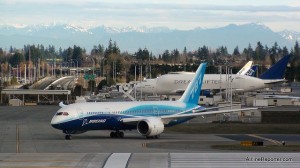
Boeing 787 Dreamliner ZA001 during its taxi testing with Dreamlifter in the background.
Boeing has learned a lot from their interactions on Twitter, from posting online media and their Boeing Store Facebook account. They are hoping to use that information to continue to grow their online presence. They hope to launch an official Boeing Facebook page (there is currently an unofficial one with 30,000 fans) and YouTube channel to share videos with the public and believe me, they have some really cool stuff.
Speaking about cool stuff, Boeing is still hip with the idea of having a TweetUp sometime. That is where a bunch of airline nerds like us (don’t take offense to that, just figure you might be one if you’re reading this) get together and talk about airplanes and do some cool things (there was one last year called Aviation Geekfest). One sponsored by Boeing won’t happen soon (there is a lot of red tape), but they are motivated to try and make it work someday (And I will continue to keep reminding them).
They are currently happy with the progress they have made, yet are still cautious about growing their online presence too quickly. “With any of these tools we have to walk before we run,” Blecher explained. “We’re far ahead of where I expected we’d be and while I’d love for us to be moving faster, I realize that trying to move too fast could put our efforts at risk. A couple of high-profile mistakes in the social sphere could really set us back.” That is a very wise approach to take. Many airlines have hopped on to the online bandwagon with great momentum, just to fizzle out with time and leaving people wondering what happened. You also don’t want to be venturing into new technology without fully understanding the impact it could have on your business or your customers.
From speaking with Blecher and Choi multiple times through their transition, I constantly get the feeling that they get it. They aren’t just pushing Boeing into the online realm because it is the new fad. Boeing is very well known for being innovative and cutting edge in many of the things they accomplish. Now they want to take that Boeing innovation mentality to the way they communicate with the outside world.
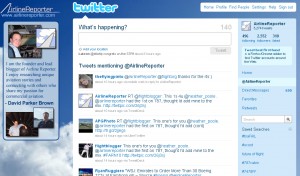
My Twitter page, where all the action happens!
I know I talk about Twitter on my blog quite a bit. I get a mixed-bag reaction from people about what Twitter is and how it works. I use it a lot and link to quite a few interesting stories and photos that I do not share on my blog or on my Facebook.
For those who haven’t stepped into the world of Twitter or maybe you have, but got confused with all the Twitter talk, let me try to help. If you have absolutely no interest in Twitter or learning about it, go ahead and skip this blog.
So what is Twitter? Well, it depends on who you are and what you use it for. If you have a personal Twitter, you probably are going to use it differently than a business one. I use my Twitter to #1 share interesting stories I find that I might not blog about #2 Let you know real-time what I am doing, if I am doing an aviation-related event #3 Connect with airlines, others who write in aviation, and my readers in a way I cannot do with other mediums. If you use Facebook, Twitter is a lot like your status updates. If you don’t use Facebook, Twitter is like a blog and instant messaging that mated and had kids. If you don’t know what blogs or instant messages are, I don’t think I can help :).
The fun part is, unlike blogs or Facebook status updates, you only have 140 characters to make your point, so long-winded folks need not apply.
If you have tried out Twitter you might quickly get confused with all the @ and #’s you see everywhere. It took me a while to get used to it, but after a little practice, it works. I will just keep this simple as if you are just trying to read my and other people’s Twitter feeds.
THE @ SYMBOL:
This is used before a user name to talk about or to someone. I am @AirlineReporter on Twitter. Let’s say you see me Tweet: “hey @danwebbage, I enjoyed meeting you the other day.” That means I am talking to Dan Webb on his Twitter account. He is able to see any message that someone mentions him in and even though I am talking to him, you can still see the message. Let’s say you found this cool airline story and want to share it with me. You could be like, “@AirlineReporter I found this cool, story, what do you think? www.coolstory.com?”
THE # SYMBOL:
The hash sign represents a topic. So let’s take the Farnborough Air Show happening soon as an example. Anyone talking about that topic will put a #FARN10, so if you want to see what anyone is saying about it, you can look it up. For example, recently I did the Virgin America new flight from San Fransisco to Toronto. Anyone who was talking about that experience used #VXToronto.
THE RT:
You probably see “RT” a lot too. This stands for “Re-Tweet” and is when someone copies someone else’s origional message. Let’s say Mary Kirby (@RunwayGirl) just wrote something on her blog and Tweets about it. “Hey check out my cool new blog on in-flight entertainment.” If I like what she is saying and want my readers to see what she is saying, I can RT or repeat what she is saying. It would then look like this, “RT: @RunwayGirl Hey check out my cool new blog on in-flight entertainment.” So you know the original message was done by Mary, but I repeated it. Now if someone then RT’s my Tweet, it can get complicated and look like this, “RT: @AirlineReporter RT: @RunwayGirl Hey check out my cool new blog on in-flight entertainment. ” Someone doing the RT can also make comments. Remember that cool story you Tweeted to me earlier? Let’s say I want to share that with my readers and I RT it with a comment, like this, “Awesome! RT @YouTwitterName: @AirlineReporter I found this cool, story, what do you think? www.coolstory.com?” Don’t worry if it is starting to sound confusing. With a little playing around, you will get the hang of it!
You do not need to create an account to read Twitter, but it sure helps. By creating an account, you are able to add people that interest you onto your friend’s list (that is my friend’s list) and see what they are Tweeting. When you get a little practice you can create groups. Like I created a group of airlines on Twitter that I will look at to see what they are Tweeting about. If you do create an account, it can be totally anonymous, all of Twitter can be anonymous if you want. You decide what information you let people know about.
It is ok if it is confusing at first. It took me a few months to get the hang of it and longer than that before I even know what the #-tag was for. After a while you get used to it and really use it as a resource to see what is going on in the world and connect to people and companies in ways you never have before. You can read about your Aunt Frannie feeding her cat and even hear about awesome travel deals, all in one spot. And I will tell you what…if you run into trouble or have any questions, go ahead and ask me and I will see if I can help you out!
Ok, if you will excuse me, I need to Tweet about this blog now!
To learn more try these out:
* About Twitter page
* The wiki article on Twitter really helps
* Video showing how using Twitter for personal use works
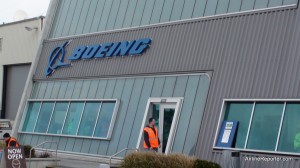
Boeing facility at Paine Field. Photo taken by me during my Boeing 787 interior tour.
When the Boeing’s 787 Dreamliner first took flight back in December 2009, there were those who questioned if Boeing really missed out on a customer relations opportunity.
Yes, Boeing had a live video feed on the internet and posted some wonderful photos and videos on their special newairplane.com website, but it still left some wanting more. People questioned why weren’t they on Twitter? Why didn’t they provide more for those that love Boeing? I somewhat agreed and felt that Boeing was making an effort, but was still distant from their fan base.
However, I think things are changing.
I have always been a frequent visitor to boeing.com, however I have been very impressed with their newer website newairplane.com. It isn’t just dry information that airlines or engineers might be interested in, but something that can really build passion for the Boeing brand. You can check out what new liveries will be on the Boeing 787 Dreamliner, take a virtual tour of both the Boeing 787 or the Boeing 747, find lots of great multimedia, and much more. It looks like I am not the only fan. Bernard Choi, with Boeing Communications, tells me that newairplane.com gets about 5-6million page views each month. That alone is a great indication, people want a closer relationship to Boeing.

Boeing facility at Paine Field where the Boeing 767, 777, 747 and 787 are made.
Boeing has also stepped into the world of Twitter. They now have three accounts: @BoeingAirplanes, @BoeingCorporate, and @BoeingDefense. And really, they are doing an outstanding job, especially only being on it for about two weeks. This week, they had their first real test of social media and I think they passed.
John Windsor, who specializes in marketing and advertisement, blogged that his son sent a photo to Boeing of a new airplane with a pretty cold response. Boeing sent a canned reply stating they do not take any outside ideas and have destroyed his son’s information. Of course this is a form letter sent to anyone who submits an idea and they didn’t have a specialized form letter to reply to a child. Honestly, it made Boeing look like it has no compassion.
A few people Tweeted the blog and it got to Boeing. Boeing Tweeted, “The letter Mr. Winsor posted is, as he said, a required response. For kids, we can do better. We’ll work on it.” Cool. They could have defended their actions, but admit that it was not appropriate and they want to improve the way they do things.
Also, Boeing Corporate Communications director Todd Blecher, also made a comment on Mr. Windsor’s blog:
“Mr. Winsor…I think I can address your comments. As you state, we have to respond to the thousands of unsolicited ideas we receive in a way that protects us against possible infringement claims. Having said that, we can do better when the idea clearly comes from a child as enthusiastic as your son. We will work on this. I hope Harry remains fascinated by airplanes and grows up to be an airplane designer. To help him and others like him we maintain the following website. I hope he enjoys it.”
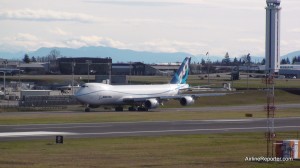
The Boeing 747-8 during taxi testing at Paine Field before its first flight.
To me, that is quite awesome. He made his comment right after I made mine and I like to think I am quite quick. With all the changes and this Twitter incident, I started to wonder if Boeing was trying to directly interact with customers more than they have in the past.
I decided to try and find out. I wrote to a few folks at Boeing and heard back from Todd Blecher (remember he is the Boeing Corporate Communications director that made the blog comment) very quickly. I asked if Boeing was consciously making an effort to connect better and how they were going to respond to Mr. Winsor’s son, Harry.
Blecher assured me that Boeing will be sending Harry some items and he actually spoke with him on the phone, thanking him for his drawing and he hopes when Harry grows up, he will design airplanes for Boeing.
He also confirmed my hunches that Boeing is making a real effort here. “We spent much of the past 12 months developing and now executing an approach to online communications that makes sense for Boeing and our audiences. We figured out what we could bring to the table and how we would be willing to engage. We drew inspiration from many areas, including Randy’s Journal, newairplane.com, our corporate advertising, and other organizations.”
They realize they are new to this game and the transition won’t happen overnight. “We are learning as we go but I have no doubt that are on a journey that will see us really change the way Boeing communicates…the bottom line is we’re changing.” When I asked Blecher about their future plans he told me they are looking at Facebook, thinking about a future mobile app and possibly even a Boeing TweetUp (where people on Twitter get together, ie Aviation Geekfest). Boeing talking about a TweetUp? That’s amazing.
Blecher realizes they might not make everyone happy. “Not everybody in our audiences will like our approach. But, to paraphrase Sinatra, we’re doing it our way because to try it any other way, to expect an organizational mindset to change overnight, is a sure way to set yourself up for a lot of frustration and aggravation and mistakes.” Even if they might make a few mistakes and frustrate a few people, I think it will be worth it in the long-run.
Who knows, if Boeing can really build that brand loyalty, maybe more people will be saying, “If it ain’t Boeing, I ain’t Going!”
connect | web | twitter | facebook |









